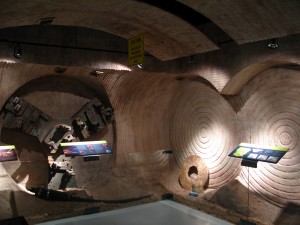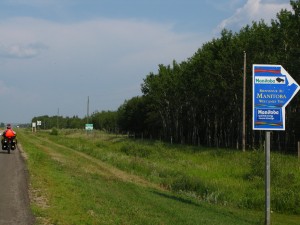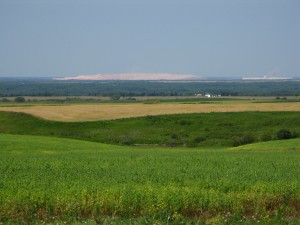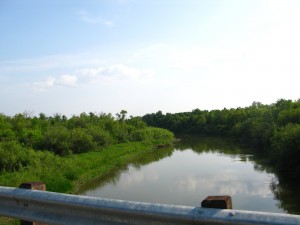Our ride out of Saskatchewan was on one of those days when you feel like you could ride forever. The sun was shining, but it wasn’t too hot – the wind was blowing lightly and in mostly the right direction – the road was mostly flat except for the occasional river valley, and the cars on the road were few and far between. We stopped in Esterhazy Saskatchewan (the town where we think both Becky’s grandmother’s were born – however, there are no signs of Bogars or Ondas now) for lunch and to check out the Potash Interpretation Centre. We were fascinated to learn that Saskatchewan is the world’s largest producer of potash. Potash is used in farming to provide potassium salts that are necessary for plant root development. Esterhazy has a huge potash mine at a depth greater than 1 km, and a giant pile of pink potash tailings which dominated the horizon as we got close.

A mining machine display at the Potash Museum

Potash tailings dominating the skyline

Just before entering Manitoba we saw a herd of bison. Manitoba uses the bison on its coat of arms and on highway signs – but we have yet to see Bison in Manitoba!

We were welcomed to Manitoba in both official languages! (Manitoba has a significant Francophone population)
For our first night in Manitoba we stayed at the Pool and Park campground ($15) on highway 16 (the Yellowhead) just outside of Binscarth. Upon entering the Yellowhead we were immediately unimpressed. The Yellowhead is part of the Trans-Canada highway system, but at Binscarth it was single lane with absolutely no shoulders. We had originally planned to ride highway 16 down to Minnadosa, but without shoulders or a passing lane, it just isn’t a safe place for bikes – so we altered our route and headed towards Rivers instead. We lasted a grand total of 2.5 km on the Yellowhead!
After our first night in Manitoba it occurred to us, that within the last year, we have lived at least 1 day in every timezone! Not many people can say that, as at least one of the time zones as we crossed the Pacific Ocean didn’t have anyone living permanently in it.
Our second day’s ride involved much more southing, which unfortunately meant more wind in our face. The minor roads have very little traffic and are generally in better condition than the roads in Saskatchewan; however, they are often a rough chip-seal that is very noisy for cars and slow for bicycles. The minor highways also had no shoulders, but when you can count the cars that pass you in an hour on two fingers, it isn’t really a concern.

Immediately after turning off of highway 16 onto highway 41 we saw a small model building. Upon closer inspection, it was a model made out of cement and had a plaque indicating that it was a memorial to an old school house which used to sit on the land that is now a farm.

Further along the road, after climbing a small hill, we looked west and were surprised that we could see the Esterhazy potash mine in the distance – it was 42 km away! It certainly dominated the landscape.
The western part of Manitoba where we are riding is not particularly flat. We found ourselves frequently climbing hills to get a great view of the surrounding farmland and descending into ancient river valleys, which were much lusher than the surrounding areas. Unfortunately, these valleys also often had a horrid stink associated with them. It seems that valleys are a good place for pig or cattle farms. We are definitely noticing more of the horrid smells associated with factory-scale animal farming in Manitoba than we noticed in either Alberta or Saskatchewan.
We arrived in Oak River at 6 pm and hoped to find camping there, but no such luck. They are in the process of building a small community campground, but nothing is in place yet. We talked briefly to some locals, but soon realized that it wasn’t going to work out, so we hopped back on the bikes and continued our slog down to Rivers Provincial Park. We have found that the people of Manitoba are much more reserved and sometimes even defensive compared to those in Saskatchewan. The drivers of cars often ignore our waves, where in Saskatchewan they often initiated the waves. The license plates for Manitoba says “Friendly Manitoba”, but the friendliness seems to be more of a goal for Manitobans rather than a reality – of course this is an over generalization, and we are meeting many wonderful, friendly people – it is just that the average person we interact with in grocery stores or on the road aren’t as openly friendly as those we cross paths with in Saskatchewan.
By 8 pm, we pulled into Rivers Provincial Park, which is located on a reservoir called Lake Wahtopanah. The campground was nicely treed and rather pretty, and the bugs were not too irritating. The lake appears to be a favourite destination for folks with power boats that like tubing and water skiing, as well as a few people fishing. Fortunately, the sun was setting at we arrived, so we were spared the constant buzzing of boats zipping up and down the narrow lake. Unfortunately, the campground was too close to a pig or cattle farm. Overnight the wind was calm, so we didn’t notice it much, but in the morning it was absolutely horrid – so bad that Becky had a hard time eating. We met some folks that planned to spend a week long vacation camped at this park and were amazed that they did not seem to notice or be bothered by the smells. We can only guess that after a while you get numbed to it.
After two long days, we were happy that the ride from Rivers to Shilo was only 70 kilometers. It was another hot day – it seems we are in the middle of Manitoba’s first real hot streak of the summer. Everyone keeps telling us that it is first real days of summer they have had this year and most people are happy for the heat.
We took a lunch break in Brandon, which turned into several hours of eating, getting some groceries, checking email, and enjoying a great soft ice cream cone. Each time we stopped, someone approached us to ask about our bikes and our trip. For the first time in Manitoba, we saw some of the friendliness that we know is out there. It seems that people are shy at first, but once they start talking we end up have more interesting and deeper conversation than we have had in other places.
After our extended break in Brandon, we hopped back on the bikes and headed out to the army base at Shilo (CFB Shilo). We had a great whirlwind visit with Becky’s cousin Stephen and his wife and daughter (Heather and Isabelle). Since Stephen is one of the few long-term army soldiers who has only been to Afghanistan once, he is expecting to be called for a second tour of duty sometime within the next year. Most of the people he works with have been two or three times already. We were surprised to learn that Canada sends 17 year old soldiers (new recruits whose parents signed the waiver allowing them to enlist so young) on tours of duty to Afghanistan – it is tough to imagine sending such young kids to war.
Melville Sask to Binscarth Manitoba, 146 km, 7 h
Binscarth to Rivers, 145 km, 7h 40 min
Rivers to Shilo, 71 km, 4h 20 min

Our first view of the Assiniboine River. It winds through western Manitoba to join the Red River at “The Forks” in Winnipeg.

Giant Paterson Grains elevator in Binscarth, bigger than most others we’ve seen

The first field of sunflowers we’ve seen

Steven, Isabella and Becky in Shilo
Download GPS Track in GPX format
I came across your site while researching HP Velo recumbents. Started reading the blog, and realized that Katrina’s mom was our child care provider 10 years ago (Zachary and Jacob). Small world. (Tony and Tony 🙂
I’m a bike rider from California. Love your blog.
I am making a presentation on potash production that will be used by various colleges in North America. Could I have permission to use the photo on your website of the “Potash tailings dominating the skyline”
Thanks.
Hi Rob,
Glad you are enjoying our blog.
Sure, no problem with using the picture in a presentation. If you need a better resolution version, just let us know. Please attribute it to “Scott & Becky at http://goingeast.ca”
Thanks
Becky
Dear Scot and Becky,
we came to attention of your blog while searching for pictures of tailings piles. I would like to give you more details on our request by e-mail. Would you please sent me your e-mail adress to tina.mueller@ercosplan.com
Looking forward to hear from you.
Best regards,
Tina
Hi Becky,
May I also use that photo of the potash tailings? It’s for a document as part of my master’s degree. I will cite appropriately. Thanks in advance 🙂
– Nick
Sure. Thanks.